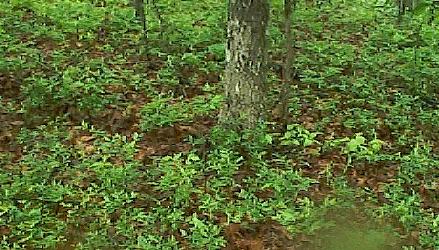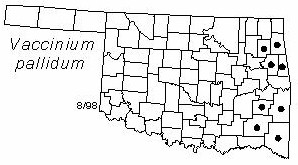
Small clonal shrub to 60 cm (24 in) tall. Bark green. Twigs light to dark brown, pubescent when young, glabrous with age, glandular-warty. Leaves alternate, simple, elliptic, 2.5-5 cm (1-2 in) long; glabrous, may be pubescent along veins beneath; color dark green above, paler beneath; cuneate at base, acute to acuminate at apex, margins finely serrate; petiole, if present, short and pubescent. Flowers 4-6 mm (0.2-0.3 in) long; calyx 5-lobed, acute; corolla 5-lobed, green-white to pink, stamens 8-10; flowers appear from March to May. Fruits berries, 5-8 mm (0.2-0.3 in) diameter, subglobose, dark blue to black; fruits mature June to July.
Distribution: Oklahoma, Arkansas, east to Alabama and Georgia, north to New York, west to Missouri. Common in eastern Oklahoma.
Habitat: rocky hillsides in the Ouachita Mountains and Ozark Plateau.
NWI status: FAC+
Comments: Vaccinium is the classical name for blueberries; pallidum refers to the pale or glaucous leaves.
Field identification: lowbush blueberry is similar in appearance to rabbit-eye blueberry (Vaccinium virgatum), however lowbush blueberry has glandular-warty stems.
Horticulture: lowbush blueberry entered cultivation in 1884. Fruits are delicious.
Wildlife benefits: fruits are eaten by turkeys, grouse, gray fox, rabbits, and deer.
Distribution in Oklahoma: 
BACK
NEXT
RETURN TO INDEX
Last update: 9/22/99
 Go to Oklahoma Biological Survey Home Page
Go to Oklahoma Biological Survey Home Page
 Disclaimer
Disclaimer